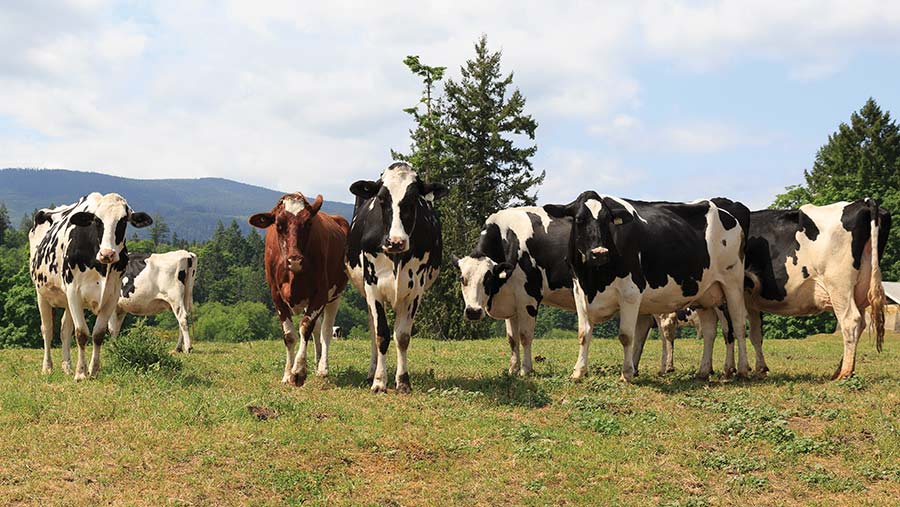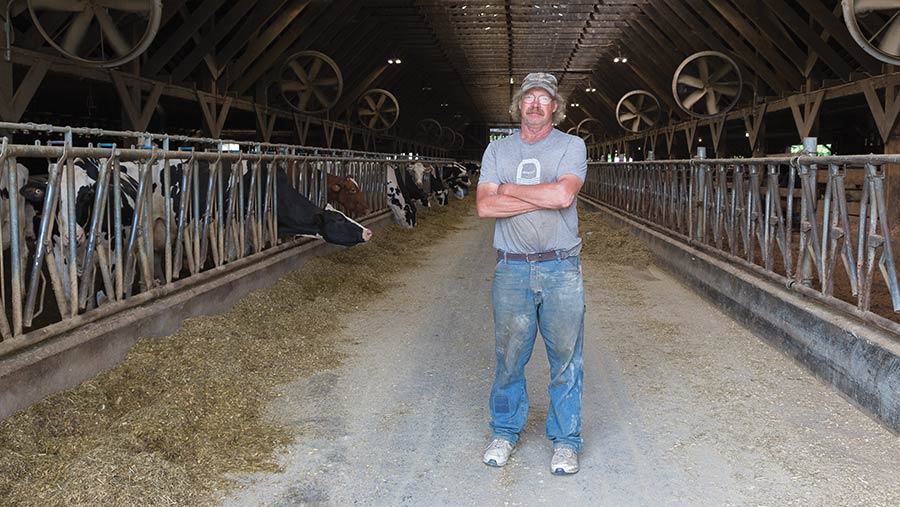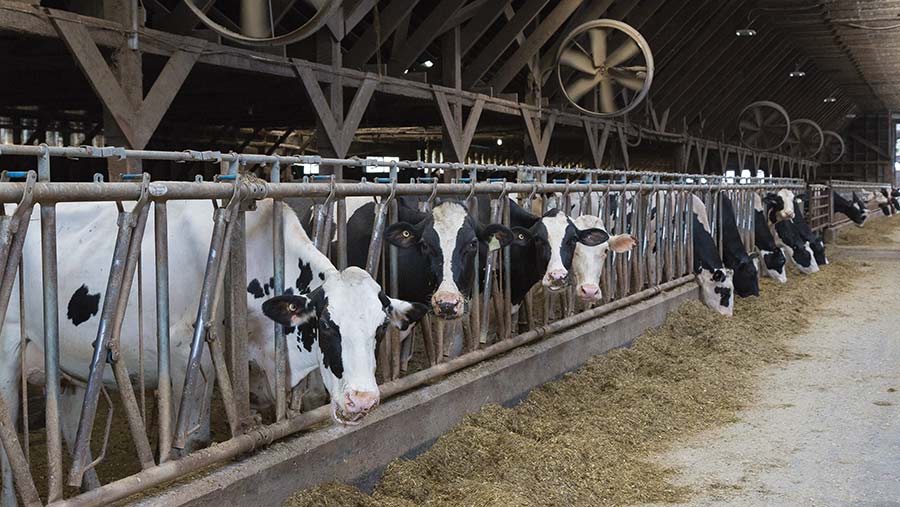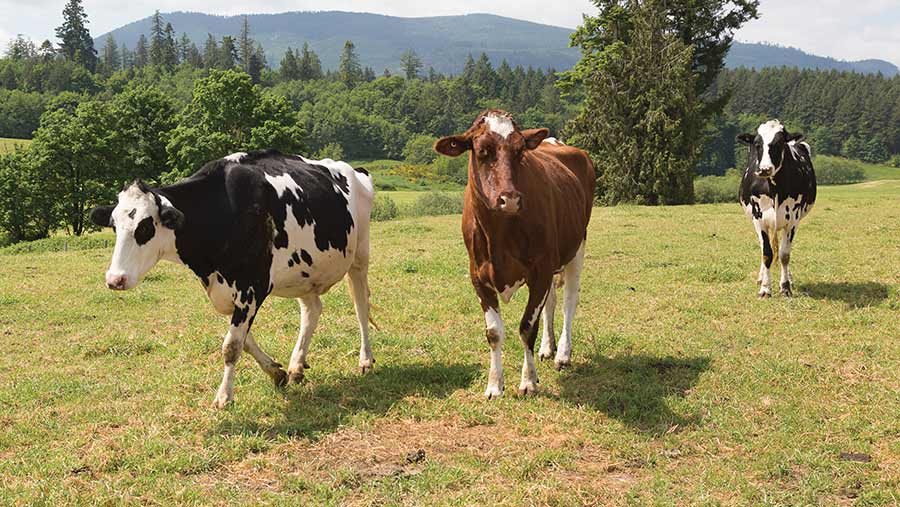How a Canadian dairy tackles heat and irrigation limits
 Dry cows at Meadow Green Farms © MAG/Judith Tooth
Dry cows at Meadow Green Farms © MAG/Judith Tooth Higher summer temperatures and limits on irrigation are prompting John Vanden Dungen and his family to find new ways of making their business more resilient.
John farms with wife Tanya and sons Ben and Pete, together with brother Adrian, partner Karen and son Daniel, and one full-time employee, in the Cowichan Valley on the south-east side of Vancouver Island.
See also: Lucerne cuts farm’s reliance on bought-in protein
The farm runs a herd of 200 Holsteins and has a daily quota of 268kg butterfat.
“We like it – it guarantees us a steady income – and the milk cheque supports the whole family,” John says. However, he adds the quota “does limit growth a bit”. Milk collection is every other day.

John Vanden Dungen © MAG/Judith Tooth
Farm facts: Meadow Green Farms, Cowichan Valley
- 154ha (380 acres), of which 113ha (280 acres) is farmed; the rest is steep or swampy ground
- 48ha (120 acres) maize and 81ha (200 acres) grass
- 200 milking Holsteins, housed
- Year-round calving
- Average yield 33-34kg/day at 4-4.2% butterfat
- Milk supplied to Island Farms dairy co-op
- Milk price 82 cents/litre (CAD$) (49p/litre)
Breeding priorities
The herd is housed and calves year round, with first calving at 22-23 months. Breeding priorities have changed in recent years to favour a slightly smaller, hardier cow.
“We hope for six or seven lactations; in practice, it’s 4.5, so we’re backing off on size and breeding a cow to last,” he says.
“Cows are more efficient producers when they’re mature.”
Cooler cows
Cow comfort in the main cubicle shed has been markedly improved during the summer by removing redundant haylofts to make room for 12 panel fans, each one 1.5m across.
These come on automatically when the ambient temperature reaches 21C.
“It has really made a difference,” says John.
“Milk yield doesn’t fall as much when it’s really hot, and conception rate still goes down, but not as much. There are fewer flies, and the cows don’t bunch up as much. Before, they would hang around and not eat a lot.”
To make use of local resources, bedding has also been changed.
“We were having trouble getting a supply of sawdust because a lot of the mills on the island have closed,” he says.
“But we have six gravel pits within 10 miles [sand is a by-product of cleaning gravel], so we’ve switched to sand.”
An on-farm sand reclamation system is nearing completion so the sand can be reused for bedding.
This will also avoid issues with sand smothering grass when spread in slurry.

© MAG/Judith Tooth
Forage management
The cows are fed a total mixed ration of 50% maize silage and 50% first-cut grass silage, along with a concentrate mix of mainly ground barley and rapeseed.
Maize is sown in mid- to late May on continuous ground in the floodplain. It germinates reliably, says John, and does not require irrigation.
“We’ve started growing cover crops of annual ryegrass and cereal rye on the corn [maize] ground to keep the soil and produce more feed,” he says.
“About one-third got drowned out [in winter], but we could focus on the higher parts of the field next time. We took a silage cut before ploughing and manuring.”
Grass under irrigation is cut four times, while non-irrigated fields receive two cuts.
First cut and half of the second cut are clamped; the rest is baled, with a few small bales made from third cut for youngstock.
Older, more fibrous first cut is also baled to feed dry cows.
Irrigation and rainfall
Irrigation water is drawn from the River Koksilah, which runs through the farm.
However, supply is tightening as the effects of extensive logging (which reduces land’s ability to store water) and more housing is seen in lower summer water levels, John says.
As one of the biggest users, farmers are among the first to see their water use limited, he says, and during August 2021, it was stopped completely; “we’re on the bottom of the totem pole after fisheries.”
Annual farm rainfall is about 900mm, mostly falling in winter, with very little from June to August.
Ben recently joined the local water management board to be better informed about issues in the area, and the family is starting to look at the viability of building a reservoir.
For now, low rainfall means a lack of forage and greater dependence on bought-in feed.
“It means buying alfalfa [lucerne], usually from Alberta, which is very expensive to get onto the island,” says John.
“We had to buy one load last year, and three the year before when temperatures reached 40C and some of our grass scorched. That season, the farm lost money.”
Some farmers in the area have tried growing lucerne, but John says it tends to get waterlogged in the winter and needs reseeding every year.

© MAG/Judith Tooth
Competition for feed
The farm is also grappling with challenges posed by a range of wildlife. Winter grazing by a herd of Roosevelt elk – a threatened species – damages low-lying grassland.
“We get compensation for crop damage, but it doesn’t really cover the loss,” says John.
“And if we try to reseed it, the elk target that field. We can fence, but the fence needs to be 8ft [2.4m] high to keep them out.
“We have two creeks, a river and a road across the farm, so that would be a lot of fencing.”
Elk also like to graze the maize, although he can protect this by running an electric fence across the valley.
However, maintaining the fence is a big job.
Vancouver Island black bears also have a fondness for maize.
“The damage varies – we might lose 20%, and sometimes it’s barely any. It seems to be down to individual bears that just like flattening it,” he says.
In the past 30 years, flocks of Canada geese that used to be migratory have become resident on the island.
They now number 30,000, says John, who has to chase geese off the emerging maize crops until the plants are 20-25cm high.
Future plans
As John approaches retirement, the next generation is planning further improvements.
With the cows milked in what he describes as “the oldest parlour running on Vancouver Island”, the first priority is to upgrade the milking system.
“The boys are hoping to put in robots – most of our neighbours are running with them now,” he says.
